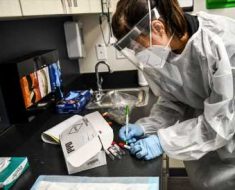School-based prevention programs can substantially reduce children’s cavities — but what type of treatment should be delivered in schools to best prevent tooth decay?
A new study by researchers at NYU College of Dentistry, published in the journal BMC Oral Health, suggests that cavity prevention programs with a combination of prevention strategies may be more effective than one alone for reducing tooth decay.
Dental cavities are the world’s most prevalent childhood disease, affecting nearly 30 percent of school-age children and 50 percent of rural, minority, or Medicaid-receiving children in the United States.
School-based cavity prevention programs have emerged as an important way to improve access to dental services. In medically underserved areas, these programs often serve as the sole source of dental care for children. While the American Dental Association supports the use of school-based cavity prevention programs, questions remain on the optimal mix of treatment services, intensity, and frequency of care.
“Given the high variability in school-based programs to prevent cavities, comparing the effectiveness of different prevention agents, frequency of care, or intensity of treatment can lead to optimal program design,” said Ryan Richard Ruff, MPH, PhD, assistant professor of Epidemiology & Health Promotion at NYU Dentistry and the study’s lead author.
In this study, NYU Dentistry researchers compared two cavity prevention programs in elementary schools serving more than 8,200 students over 10 years (2004-2014). Both programs provided school-based care twice a year to children ages 5 to 12.
One program provided sealants on molars (primary prevention) while the other provided sealants on all teeth and interim therapeutic restorations (primary and secondary prevention). Interim therapeutic restorations are a minimally-invasive method for controlling tooth decay by filling a cavity with a fluoride?releasing agent. Interim therapeutic restorations are intended to bridge the gap between identifying a cavity, particularly in a nontraditional setting or in a very young child, and having the cavity filled or crowned in a more permanent procedure.
Both school-based cavity prevention programs reduced the risk of untreated decay over time. While the total number of all decayed or filled teeth observed over the course of the study increased across both programs, the comprehensive program that provided primary and secondary prevention significantly lowered the rate of new and untreated cavities when compared to only sealants on molars.
“A comprehensive cavity prevention program, particularly for children without regular access to dental care, can be significantly better than the traditional molar sealant programs,” said Richard Niederman, DMD, professor and chair of the Department Epidemiology & Health Promotion at NYU Dentistry and the study’s coauthor.
Ruff and Niederman are continuing to study how to optimize school-based cavity prevention. They are currently leading two large studies — a PCORI-funded study in the Bronx and an NIH-funded study in New Hampshire — to compare two cavity prevention techniques in school-based dental programs. One technique is a more complex treatment similar to the combined primary and secondary prevention, but the Bronx and New Hampshire studies will also introduce the use of silver diamine fluoride, a non-invasive, cavity-fighting liquid that is painted onto teeth to halt the progression of tooth decay. The cavity prevention programs will begin in schools in the fall of 2018.
This research was supported the National Institute of Dental and Craniofacial Research (R03DE025289) and the National Institute on Minority Health and Health Disparities (U24MD006964).
Source: Read Full Article





